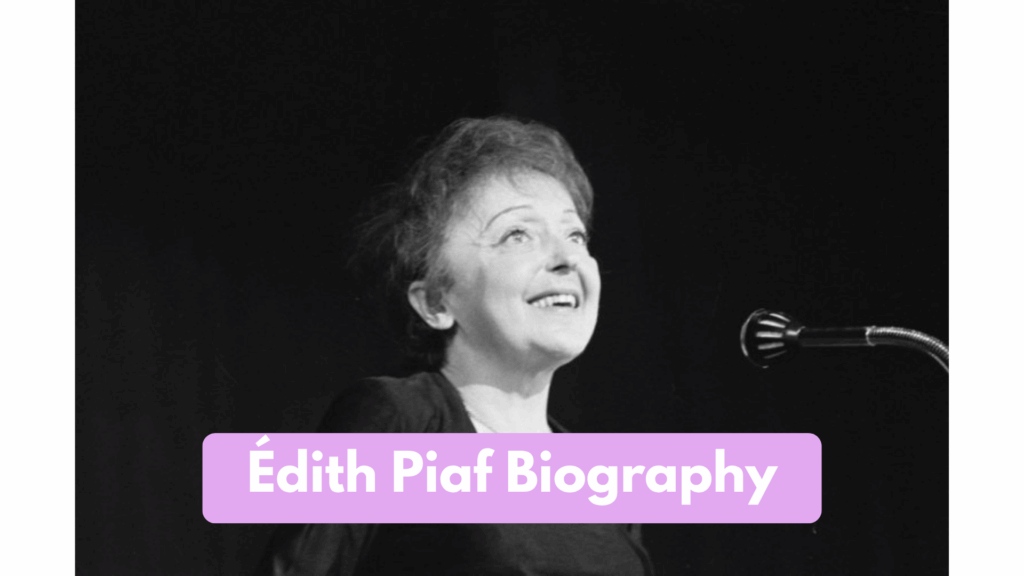Édith Piaf Biography: Cause of Death, Parent, Age, Net Worth, Wikipedia, Children

Édith Piaf — born Édith Giovanna Gassion — is one of the most celebrated voices of the 20th century. Known as La Môme Piaf (the little sparrow), her small stature belied a voice with immense emotional power.
This biography explores her early life, rise to fame, signature songs, turbulent personal life, and enduring legacy.
Early life and origins
Édith Giovanna Gassion was born on December 19, 1915, in the Belleville quarter of Paris. The daughter of a traveling street performer and a cabaret singer, Piaf grew up in poverty and learned early to sing in public places to earn money. These formative years on the streets of Paris shaped her direct, intimate singing style.
The discovery and rise to fame
In the mid-1930s a Parisian nightclub owner discovered Piaf and gave her the stage name Piaf. That discovery, combined with the support of mentors and composers, led her from street corners to cabarets and then to concert halls. By the 1940s and after World War II she had become a national and then international star.
Signature songs and collaborations
Piaf created or popularized numerous songs that became international standards. Notable titles include:
- La Vie en rose — the song most closely associated with Piaf’s image of romanticism and longing.
- Hymne à l’amour — a heart-wrenching declaration of devotion.
- Non, je ne regrette rien — a bold, defiant statement of renewal.
- Other classics: Milord, Padam… Padam…, Mon manège à moi.
Her work with gifted composers and lyricists helped produce material that matched her unmistakable vocal personality.
Personal life — love, tragedy, and struggle
Piaf’s life offstage was dramatic and often tragic. Her passionate relationship with the boxer Marcel Cerdan, which ended with his death in a plane crash, haunted her life and art. She also experienced the profound loss of her only daughter in childhood. Piaf endured chronic pain and struggled with substance dependency in later years.
Later career and final years
Despite health problems, Piaf continued performing through the 1950s and early 1960s. She married Théo Sarapo in 1962. Édith Piaf died on October 10, 1963, and was given a widely attended public funeral in Paris. She is buried in the famous Père Lachaise Cemetery.
Artistic style and cultural impact
Édith Piaf’s singing was notable for its theatricality, emotional directness, and intimate phrasing. She helped define the modern French chanson, and her songs have been covered and adapted around the world. Piaf’s life and work have inspired films, books, and stage productions — ensuring her continued cultural presence.
Legacy
Piaf remains an icon: a symbol of Paris, of the chanson tradition, and of artistic resilience. Her music continues to be discovered by new listeners, and portrayals such as the film La Vie en Rose (2007) have introduced her story to international audiences.
Conclusion
Édith Piaf’s biography is the story of a voice that rose from the streets of Paris to speak for universal feelings of love, loss, and defiance. Her influence on music and popular culture is lasting — and her recordings continue to move listeners who want music that feels deeply human.
FAQs
Who was Édith Piaf?
Édith Piaf was a French singer and cultural icon whose passionate performances and songs made her one of the defining voices of 20th-century French music.
When and where was she born?
She was born on December 19, 1915, in Belleville, Paris.
What are her most famous songs?
Her most famous songs include “La Vie en rose,” “Hymne à l’amour,” and “Non, je ne regrette rien.”
Who were important people in her life?
Important figures include her mentors and songwriters, her lover Marcel Cerdan, and her husbands including Jacques Pills and Théo Sarapo.
How did she die?
Édith Piaf died on October 10, 1963, after years of health struggles and physical ailments.
Where is she buried?
She is buried at Père Lachaise Cemetery in Paris.
Are there films about her?
Yes — most notably La Vie en Rose (2007), which dramatizes her life and won Marion Cotillard an Academy Award for the role.


